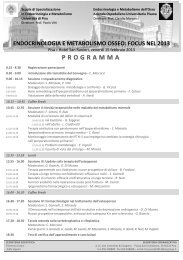You also want an ePaper? Increase the reach of your titles
YUMPU automatically turns print PDFs into web optimized ePapers that Google loves.
Diotima and kuèsis in the Light of the Myths of<br />
the God’s Annexation of Pregnancy<br />
Anne Gabrièle Wersinger<br />
In Plato’s <strong>Symposium</strong> (201d-212b), Diotima of Mantinea introduces herself in an hyper-masculine<br />
environment, through a complex apparatus of speech embedded relays and nested narratives of which<br />
the main effect is to blur the source of enunciation 1 . Reported by a male, Socrates, one of Diotima’s<br />
main thesis seems rather surprising at first sight: men’s desire (erôs) even the most manly of them, is<br />
to become pregnant (kuèsis) 2 .<br />
Male pregnancy and the Olympian and Orphic myths<br />
Scholars 3 have tried to edulcorate Diotima’s thesis, pretending that it does not imply any valuation of<br />
a feminine attribute. After all, does not Plato write in the Timaeus that a male’s seed, a divine part<br />
derived from the marrow which forms the brain, is sown in the “ploughland of the womb with living<br />
creatures too small to be seen (aorata … zôia) and that those are nourished until they grow large<br />
within” (91c8-d5)? Aeschylus seems to echo the same tradition in a passage of the Eumenides, when<br />
Athena says: “It is not the mother who is the begetter (tokeus) of what is called her child, beeing only<br />
the nurse of the newly-sown embryo (kumatos); the one who begets (tiktei) is the one who mounts<br />
(d’ho thrôiskôn)” (v. 658-660). The phallus is considered the key element for the birth, and if the<br />
maternal role has not completely disappeared, it is reduced to a nurturing function. Anaxagoras held<br />
that man’s ejaculation of seed produced an homunculus which reached it’s full size thanks to the<br />
nourishment supplied by the mother 4 . Accordingly, when Diotima says that the males aspire to<br />
pregnancy, one should understand (except by uttering something absurd) that she can’t of course be<br />
speaking of the mother’s pregnancy, but only of the condition whereby a man is ready to ejaculate his<br />
seed 5 .<br />
But, to postulate that kuèsis applied to males can’t have the usual meaning and must be<br />
interpreted in a metaphorical sense, since a male can not reasonably be pregnant, is a petition of<br />
principle that prohibits understanding why Diotima chooses this metaphor rather than another 6 . It<br />
should be noticed also that in the Timaeus, (where one would mostly expect the word to occur), kuèsis<br />
(and its derivatives) is not used by Plato. It seems therefore reasonable to assume that, as Diotima<br />
stresses the metaphor of kuèsis built on the verb kuèô 7 , she means something else than the male’s<br />
condition before ejaculation.<br />
It seems then that a better method would imply working on a material where male pregnancy<br />
is fully acknowledged, such as in the mythological tradition called “Olympian” going back to Hesiod,<br />
which points toward the annexation of the feminine function of giving birth, by the father. Thus, in<br />
Hesiod, while allocating privileges (timai) to the gods, Zeus marries Metis. When she is about to give<br />
birth to Athena, Hesiod says, Zeus swallows her into his nèdun 8 (v. 899) to avoid that some one else<br />
would take his privilege from him (time, v. 892) and then he begets Athena (Theogony, v. 886-890<br />
with the verb etikte, v. 922, implied v. 924). N. Loraux reminds us that Athena is Dios pais, Dios<br />
tekon, and above all, that she is motherless 9 . In Euripides’Bacchae, Zeus is accused of having<br />
deprived Semele from her child Dionysus, while still in her womb. He then hid the child in his thigh<br />
1<br />
Wersinger, 2011, p. 96-100 and 2012, p. 2-6.<br />
2 e<br />
<strong>Symposium</strong>, 206c1 (kueô), c7 (kuèsis), d4 (to kuoûn), d7 (to kuèma) d8 (tôi kuoûnti) ; 208 2 (egkumones), 209a1<br />
(kuoûsin), b1 (egkumôn), b5 (kuôn), c3 (ekuei).<br />
3<br />
Morrisson, 1964, p. 54.<br />
4<br />
Leitao, 2012, p. 15, speaks of « male pregancy as scientific fact » but it seems rather a deduction as the word kuèsis does<br />
not occur in what is left of Anaxagoras’work.<br />
5<br />
Morrisson, ibid., Pender, 1992, p. 72 ; Leitao thinks that there is a strategic turn in Diotima’s discourse, and agrees with<br />
Pender up to 210d5, where one has to acknowledge a feminine form of pregnancy (2012, p. 188).<br />
6<br />
Wersinger, 2012, p. 11. Unfortunately, Leitao who deals a lot with the word tiktein (p. 281-284) does not examine the word<br />
kuèsis.<br />
7<br />
Morrisson, (1964, p. 53), and Evans, (2006, p. 15, and n°2) have pretended that kueô may have the causal meaning of<br />
“impregnate” that applies to the male role in procreation, as attested in the aorist tense in Aeschylus, fr. 44, Nauck (ὄµβρος δ'<br />
ἀπ' εὐνάεντος οὐρανοῦ πεσὼν / ἔκυσε γαῖαν· ἡ δὲ τίκτεται βροτοῖς). But Aeschylus here does not employ the verb kueô (to<br />
be pregnant), but the verb kuô with an accusative that, in this case, means “impregnate”.<br />
8<br />
The word reinforces the analogy with the womb often designated by the belly or other parts of the digestive tract (e.g.<br />
Euripides, Bacchai, v. 527).<br />
9 Loraux, 1981, p. 142.




